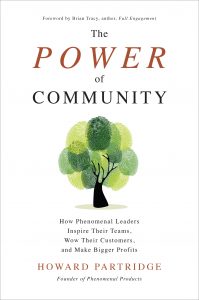Business coach and author Howard Partridge has a new book, The Power of Community: How Phenomenal Leaders Inspire their Teams, Wow their Customers, and Make Bigger Profits (McGraw Hill, 2018), that taps into a basic human need and turns it into a winning business strategy. “Every human being has a longing for belonging,” Partridge writes. Leaders who turn their organization into a cohesive community will spark that sense of true engagement and motivation that is so elusive in today’s workplace.
From leadership behaviors to creating small, focused teams, this book shows exactly how and why community works. It’s a convincing argument, an appealing approach, and even better, a method that will work for nearly any company or institution, from a brick-and-mortar to a megacorp, start-up to legacy. Community, he proves, is good for business.
Workplace culture is certainly a big subject these days. Surveys and studies all indicate that without a culture that supports and inspires its people, productivity tanks and businesses can hemorrhage personnel. Moreover, attrition and turnover have always undercut ROI, but in this highly competitive job market, more than half of all employed people are on the hunt for other jobs. That’s a risky stat for many an enterprise.
Many of these employees may say they’re not just looking for a job that simply pays better. They want to feel valued, they want to be able to care about what they do, and that they want to feel like they’re working hard at a job that has meaning. They want to feel close to their coworkers, part of a great team, and appreciated by their managers and leaders. Of those that opt to just stay with their current employer, inertia is not the same as engagement: 70 percent of employees report being disengaged, according to a recent Gallup Poll Partridge cites in the book. Low morale doesn’t just take a toll on individual performance: it can affect team members, customers, and profits.
That’s where Partridge comes in. In The Power of Community he sets the stage with a convincing narrative on how we all came to feel so alienated. We’re living and working during another industrial revolution — a digital one — and it’s a long, long way from the neighborly villages of long ago. This is also an era marked by endless change, he notes: multigenerational, multicultural workforces, held together via remote conferencing and virtual meetings — overstressed, underskilled, distracted, unacknowledged.

Yet too many leaders are still working from an old model of management based on “command and control.” That leadership style includes woefully little give and take, and has an impersonal approach to people that can come off as heartless. According to Partridge, it’s an approach leftover from the factory floors of the first industrial revolution — and it won’t work today.
What leaders need to bring to the workplace is a commitment to support, encouragement and accountability. It all starts with what the leaders do and how they do it — this isn’t trickle down, it’s specific, intentional re-framing. Hire the right people, create solid relationships with them, and build a network of “champion connections” that can expand outwards into the organization. The aim is to create a family, but a functional one, aligned with the leader’s objectives, a growing culture that values each relationship and celebrates the connection of minds and hearts.
The range of smart strategies in this book will give leaders all the tools they need to head a real transformation and then maintain it. There are also true stories about business people who have followed Partridge’s methods and turned around a stagnant office, a disgruntled team, or an entire enterprise. Leaders recall the shift they made — usually with the sole intent of saving their business — and how by so doing, something far greater happened.
As they became more involved in the lives and dreams of employees, the employees became more involved in the mission and goals of the organization. What goes around comes around, as they say, and it turns out, this is a powerful way to stay competitive. Happier employees transmit that people-centric culture outwards, and customers notice.
We’ve all seen companies that have loyal employees more than willing to stay late, push harder, and give it their all. They believe in the mission of their company, but that’s only half of it. The company — and its leaders — believe in them. What Partridge offers in terms of building a community-based workplace culture goes way beyond marketing slogans or trendy management systems. It’s a highly practical approach that’s scaffolded on decades of experience as a business coach, filled with common sense, upbeat inspiration, and a reassuring focus on a business’s greatest asset — its people.
For more about Howard Partridge, visit his website
 Blogcritics The critical lens on today's culture & entertainment
Blogcritics The critical lens on today's culture & entertainment




